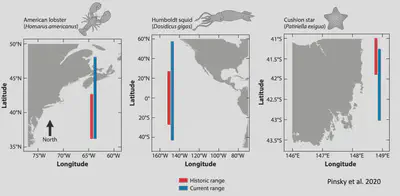Research

I am a quantitative marine ecologist interested in the intersections among marine ecosystem dynamics, climate change, marine management, and adaptation strategies within coastal communities. I am committed to transparent and open research and data science.
The role of artificial structures in rocky reef community structure

The estimated footprint of human-made structures in the ocean is 32,000 km-squared and that number is expected to rapidly increase over the next decade as nations rely more on marine resources such as aquaculture and energy (Bugnot et al. 2021 Nature Sustainability). Many organisms in the ocean rely on structures for settlement, food, and shelter. Subsequently, a range of human-made structures from trashed lightpoles off the coast of Santa Monica, CA to oil and gas rigs in the Gulf of Mexico support communities of flora and fauna. When designed intentionally, these structures can support healthy and productive ecosystems that can boost biomass of important fisheries species, absorb carbon from the ocean, and protect shorelines from storms and coastal erosion. I am currently working to better understand the role that artificial structures made of diverse materials across environmental conditions play in the broader Southern California Bight ecosystem.
Range shifts in the Anthropocene

Organisms across the tree of life–from humpback whales to viruses, song birds to mycorrhizal fungi–are moving where they live. The ocean presents an especially exciting place to learn about how and why species move to new locations because it’s typically easier to move around in the ocean versus on land, and because ocean habitats facilitate narrow thermal tolerances. However, we are still just beginning to learn about how the identity of a species, population dynamics, location, and interactions shape the likelihood and extent of a shift in where a phytoplankton, fish, or whale is found, and where it will be found 5, 50, 100 years in the future.
I am interested in how species traits such as generation time, mobility, and reproductive strategy may play a role in shaping species range shifts. Additionally, I am interested in how these traits vary across a species range, and how this variability may play into range expansions and contractions in response to environmental change and fishing pressure.
Currently, I am working to understand the impacts of range shifts on community structure of demersal fish around the world in partnership with the FISHGLOB consortium.
Coastal communities and environmental change

People living in coastal areas face unprecedented transformations of their homes, neighborhoods, and livelihoods due to changing resource distributions, sea-level rise, and increasing storm intensity. In New York City, rising sea levels threaten transportation infrastructure and the viability of neighborhoods, especially in South Brooklyn and Queens. In southern California, increasing intensity and regularity of winter storms is leading to rapid erosion of dunes and beaches. In response to changing resource distributions and availability, fishermen are having to make difficult decisions of whether or not to stay in the fishing industry, and if so, how to shake-up what they are catching or where they are fishing. I am currently working to assess how fishermen vary catch portfolios and fishing grounds to match resource availability, and how management structures can be improved to allow for flexibility.
Are you interested in collaborating on any of these themes? Let’s chat!